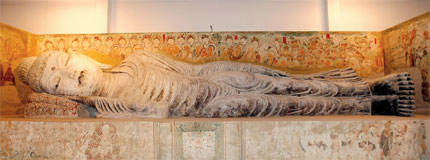Visitors enter Dunhuang grottoes
 0 Comment(s)
0 Comment(s) Print
Print E-mail
Shanghai Daily, October 31, 2011
E-mail
Shanghai Daily, October 31, 2011
|
|
|
The replicated giant reclining Buddha in Cave 158 (four-fifths of the actual size) is the most valued treasure in the current exhibition of Dunhuang art in Shanghai. |
Replicas of famous Buddhist statues and frescoes from the Dunhuang grottoes in Gansu Province are on display in cave-like settings in Shanghai through November 18.
Visitors will step into exactly reproduced "caves" to get the feel and context of the grottoes of ancient art.
"Highlights from Mogao Grottoes" is part of Gansu Culture Week in the 13th China Shanghai International Arts Festival.
The exhibition includes three exact reproductions of large Dunhuang grottoes, 10 reproductions of statues, 30 duplicate frescoes and 10 authentic documents and texts unearthed from the caves.
The exhibition is underway at the Expo Foot Print Pavilion, also known as the Shanghai Expo Memorial Exhibition Pavilion.
Dunhuang was an important stop on the Silk Road that connected ancient China with Central Asia and Europe. It was a place where multiple cultures intersected on the trade route.
The caves, frescoes and sculptures are considered a World Cultural Heritage by UNESCO.
So far 812 caves have been discovered in the region, with artwork from the 4th century BC to the Yuan Dynasty (1271-1368). They contain more than 2,000 colored works of sculpture and 45,000 square meters of preserved frescoes.
Dunhuang's art from an early period is a precious cultural legacy, says Fan Jinshi, president of the Dunhuang Academy. Most treasures in museums were created relatively late in Chinese history, while Dunhuang represents art from the Sui (581-618) and Tang (618-907) dynasties, she notes.
Most of the early frescoes and sculptures represent Buddhist stories and early Chinese legends.
Art from the Sui and Tang dynasties depicts lives of ordinary people, while the later works include paintings and sculptures of ethnic group leaders and Buddhist donors.
The three duplicate Dunhuang grottoes were transported to Shanghai for the exhibition. They represent a complete work of art, containing painted ceilings and walls, granite floors and the frescoes and statuary.
The duplicated grottoes are Cave 45 from the Tang Dynasty, 705 to 780; Cave 29 from the Yulin Grottoes created in Western Xia Dynasty from 1036 to 1226, and Cave 158 (four-fifths of the actual size) created in the mid Tang Dynasty from 781 to 847.
Cave 45 is famous for the fresco of "Flying Apsaras" (celestial nymphs) and colored Buddha sculptures; Cave 29 is especially valued for the ethnic and regional elements depicted in the frescoes; the giant reclining Buddha in Cave 158 is the most valued treasure in the current exhibition, according to Luo Huaqing, vice president of the Dunhuang Academy.
The Buddha is based on the story of Sakyamuni passing away in his sleep after eight years of teaching ordinary people. He lies on his right side and his tranquil face wears a smile, as if he had a pleasant dream. In the frescoes nearby, his distraught followers weep in grief.
Though the Buddha is four-fifths of the actual size, it is still 12 meters long and was difficult to transport. It was separated into four parts for transport and reassembled in the exhibition hall.
Despite that the works are reproductions, they are of great value. Copying the frescoes and sculptures has made it possible to study Dunhuang art and spread appreciation of the art among people who cannot visit the original.
The artwork has been reproduced since the 1940s and some of the artists started copying frescoes and sculpture when they were in their teens. Today they are masters and the eldest is 89 years old and still working.
"Many anonymous artists have devoted their lives to preserving and transmitting Dunhuang artwork," says Fan, president of the Dunhuang Academy.
A number of authentic documents are on display, including a restaurant bill from the Song Dynasty (960-1279), which attracts many visitors. Study of the documents yields information about politics, economy, religion and culture.







Go to Forum >>0 Comment(s)